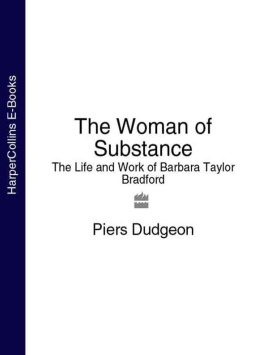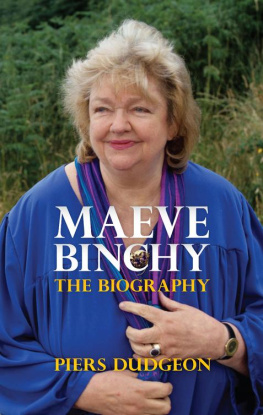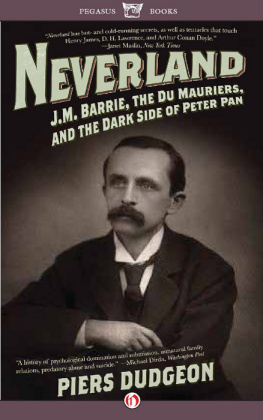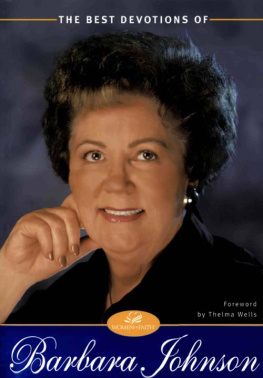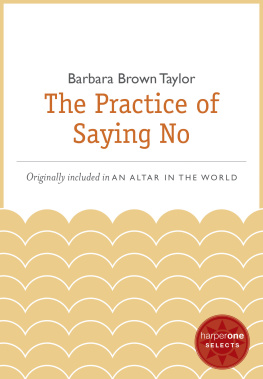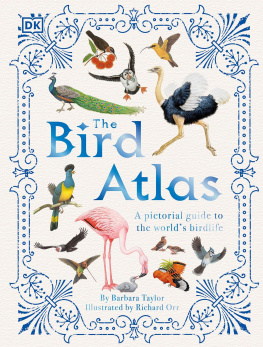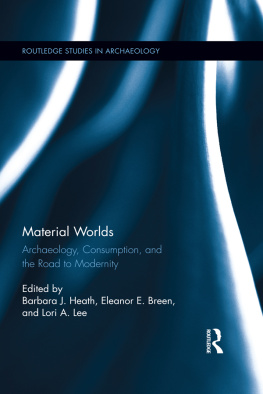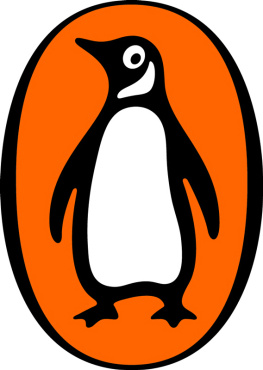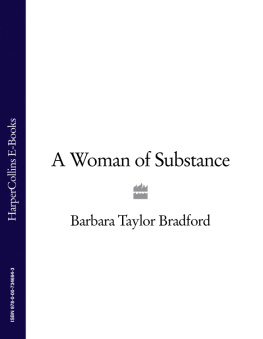The Woman of Substance
THE SECRET LIFE THAT INSPIRED
THE RENOWNED STORYTELLER
Barbara Taylor Bradford was born and raised in England. She started her writing career on the Yorkshire Evening Post and later worked as a journalist in London. Her first novel, A Woman of Substance, became an enduring bestseller and was followed by twenty-five others, including the bestselling Harte series. Barbaras books have sold more than eighty-one million copies worldwide in more than ninety countries and forty languages, and ten mini-series and television movies have been made of her books. In October of 2007, Barbara was appointed an OBE by the Queen for her services to literature. She lives in New York City with her husband, television producer Robert Bradford.
Piers Dudgeon is the author of many works of nonfiction. He worked for ten years as an editor in London, before starting his own publishing company and producing books with authors as diverse as John Fowles, Catherine Cookson, Peter Ackroyd, Daphne du Maurier, Shirley Conran, Ted Hughes and Susan Hill. In 1993, he left London for the North York Moors, where he has written biographies of Sir John Tavener, Edward de Bono, Catherine Cookson, Josephine Cox, J M Barrie and Daphne du Maurier. He is currently working on a series of oral histories of post-industrial Britain and a book about the poet Ted Hughess childhood.
CONTENTS
Section 1
Section 2
Section 3
Section 4
Exploring one of the worlds most successful writers through the looking glass of her fiction is an idea particularly well suited in the case of Barbara Taylor Bradford, whose fictional heroines draw on their creators character and chart the emotional contours of her own experience, and whose own history so often emerges from the shadowland between fact and fiction.
She turned out to be unstintingly generous with her time, advising me about real-life places, episodes and events in the novels, despite a hectic round of her own, which included the writing of two novels, the launch of her nineteenth novel, Emmas Secret (2003), a high-profile legal action in India against a TV film company suspected of purloining her books and films, a grand party celebrating a quarter of a century with publishers HarperCollins, and a schedule of charity events, which film producer, business manager and husband Robert Bradford arranged for her oh, and a week or sos holiday.
Barbaras first novel, A Woman of Substance, is, according to Publishers Weekly, the eighth biggest-selling novel ever to be published. It has sold more than twenty-five million copies worldwide. In it, so reviewers will tell you, we have the classic Cinderella story. Emma Harte rises from maid to matriarch; the impoverished Edwardian kitchen maid comes, through her own efforts, to rule over a business empire that stretches from Yorkshire to America and Australia.
What it took to escape the constraints of the Edwardian and later twentieth-century English class system is at the heart of Barbaras familys own story too. Her rise to bestselling novelist and icon for emancipated womanhood, currently valued at some $170 million, from a two-up two-down in Leeds is by any standard extraordinary. Her elevation coincided with the post-war drift from an Edwardian upstairs/downstairs class system (into which Barbaras mother Freda was born), reconstructed by socialism in the period of Barbaras own childhood, to one ultimately sensible to merit, a transformation which finds symbolic incidence in the year 1979, in which A Woman of Substance was first published and that champion of meritocracy, Margaret Thatcher, who had risen from the lower middle classes to become Britains first female Prime Minister, arrived at No. 10 Downing Street.
Barbaras novels, which encourage women to believe they can conquer the world, whatever their class or background and despite the fact that they are operating in a mans domain, tapped into the aspirational energy of this era and served to expedite social change. Indeed, it might be said that Barbara Taylor Bradford would have invented Margaret Thatcher if she had not already existed. When they met, there was a memorable double take of where ambition had led them. I was invited to a reception at Number Ten, Barbara recalls. I saw a picture of Churchill in the hall outside the reception room and slipped out to look at it. Mrs Thatcher followed me out and asked if I was all right. I just said: I never thought a girl from Yorkshire like me would be standing here at the invitation of the Prime Minister looking at a portrait of Churchill inside ten Downing Street, and she whispered: I know what you mean.
More intriguingly, in the process of writing fiction, ideas arise which owe their genesis not to the culture of an era, but to the authors inner experience, and here, as any editor knows, lie the most compelling parts of a writers work. Barbara is the first to agree: Its very hard when youve just finished a novel to define what youve really written about other than what seems to be the verity on paper. Theres something else there underlying it subconsciously in the writers mind, and that I might be able to give you later. She promised this to journalist Billie Figg in the early 1980s, but never delivered, though the prospect is especially enticing, given that she can also say: My typewriter is my psychiatrist.
There is no pearl without first there being grit in the oyster. The grit may lie in childhood experience, possibly only partly understood or deliberately blanked out, buried and unresolved by the defence mechanisms of the conscious mind. Unawares, the subconscious generates the ideas that claw at a writers inner self and drive his or her best fiction.
Barbara shies away from such talk, denouncing inspiration it is, she says, something that she has never had. She admits that on occasion she finds herself strangely moved by a place and gets feelings of dj vu, even of having been part of something that happened before she was born, but mostly she sees herself as a storyteller, a creator of stories, happy to draw on her own life, all of it perfectly conscious and practical. Later we will see how she works up a novel out of her characters, which is indeed a conscious process. But subconscious influences are by their very nature not known to the conscious mind, and we will also see that echoes of a past unknown do indeed inhabit her writing.
Barbara will tell you that it was her mother, Freda, who made her who she is today. Mother and daughter were so close, and Freda so determined an influence, that their relationship reads almost like a conspiracy in Barbaras future success. Freda was on a mission, a crusade, but it wasnt quite the selfless mission that Barbara supposed, for Freda had an agenda: she was driven to realise ambition in her daughter by a need to resolve the disastrous experiences of her own childhood, about which Barbara, and possibly even Fredas husband, knew nothing.
In fact, Barbaras story turns out to be an inextricable part of the story of not two but three women herself, her mother Freda, and Fredas mother, Edith, whose own dream of rising in the world turned horribly sour when the man she loved failed her and reduced her family to penury. It left her eldest daughter Freda with enormous problems to resolve, and a sense of loss which, on account of her extraordinarily close relationship with Barbara, found its way into the novels. One might even say that in resolving it in the lives of her characters Barbara appeased Freda and, in her material success, actually realised Ediths dream.

